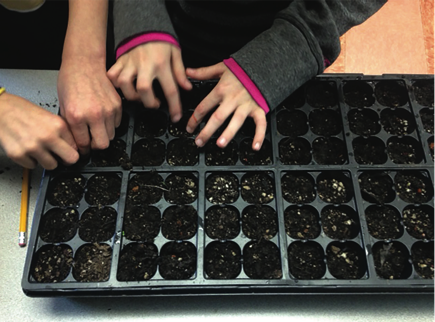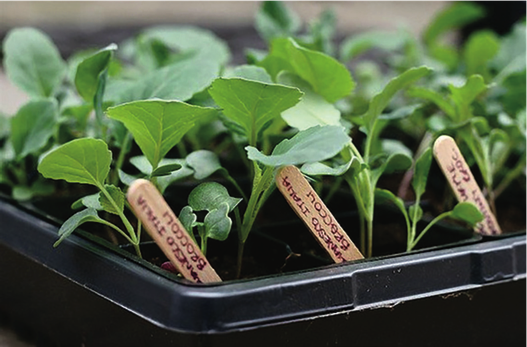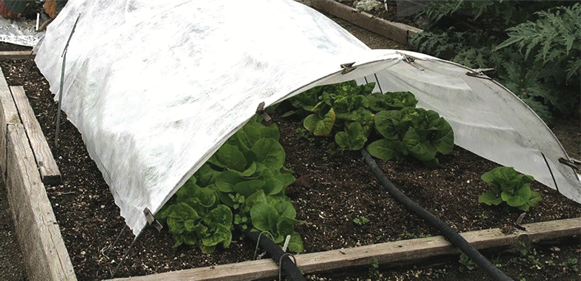Start Your Summer Vegetable Garden Early
By Joyce Gemmell
 With attention to a few critical details, anyone can be a successful vegetable gardener. There is nothing more satisfying than putting dinner on the table and proudly sharing, “I grew the zucchini!” (or corn or carrots or green peppers ... ).
With attention to a few critical details, anyone can be a successful vegetable gardener. There is nothing more satisfying than putting dinner on the table and proudly sharing, “I grew the zucchini!” (or corn or carrots or green peppers ... ).
All of the crops we think of as summer vegetables are designed to grow and produce between the last frost of winter and the first frost the following season. These vegetables require higher soil and air temperatures and more sunlight than winter vegetables. They will mature during warm weather but can be started from seed in a protected location in the cool months of January and February. It can take five to six weeks from germination before the seedling is ready for planting. Seeds begun indoors can be started in any container that has drainage holes in the bottom and has been sterilized in a 10% bleach solution: for example, regular nursery pots, seedling trays, yogurt containers and plastic clamshells from the grocery store are all suitable if they have been sterilized.
 Seed packets list optimum temperatures for germination and give a time frame for when plants will germinate and produce. A rule of thumb is that seedlings can be transplanted as sprouts when the second set of leaves, called “true leaves,” appear. These starts can be planted outside in the garden after the last frost, which for San Diego occurs around the end of January. Once in the ground, outside air temperatures can be managed by using floating row covers over young plants. Row covers will mitigate the cold temperatures and protect the seedlings until the air temperature is warm enough to support growth without them. Summer veggies should be moved from their seedling trays and planted in the ground during the March-April time frame when the soil begins to warm up. If veggies are planted too soon, they will grow slowly and will produce a smaller harvest. For example, corn and melons should be planted no earlier than May in San Diego, otherwise, they will not grow and flourish because the air and soil conditions are not right. Soil thermometers are a good way to gauge soil temperatures. They are widely available online or in local garden centers. One can also search on the California Irrigation Management Information System (CIMIS) at their website, cimis.water.ca.gov, which is a network of weather stations for irrigation management. CIMIS stations also report soil and air temperatures; checking historical data may be useful to gauge conditions at your specific location.
Seed packets list optimum temperatures for germination and give a time frame for when plants will germinate and produce. A rule of thumb is that seedlings can be transplanted as sprouts when the second set of leaves, called “true leaves,” appear. These starts can be planted outside in the garden after the last frost, which for San Diego occurs around the end of January. Once in the ground, outside air temperatures can be managed by using floating row covers over young plants. Row covers will mitigate the cold temperatures and protect the seedlings until the air temperature is warm enough to support growth without them. Summer veggies should be moved from their seedling trays and planted in the ground during the March-April time frame when the soil begins to warm up. If veggies are planted too soon, they will grow slowly and will produce a smaller harvest. For example, corn and melons should be planted no earlier than May in San Diego, otherwise, they will not grow and flourish because the air and soil conditions are not right. Soil thermometers are a good way to gauge soil temperatures. They are widely available online or in local garden centers. One can also search on the California Irrigation Management Information System (CIMIS) at their website, cimis.water.ca.gov, which is a network of weather stations for irrigation management. CIMIS stations also report soil and air temperatures; checking historical data may be useful to gauge conditions at your specific location.
Air temperature is the easiest growing variable to monitor; sunlight is also easy to monitor. Gardeners can look at websites such as www.timeanddate.com, to find San Diego sunrise and sunset, daily sunlight amounts and a graph that shows the daily sun by date. Gardeners can also monitor the sunlight in their own yard by observing when their vegetable garden receives and loses sunlight. The optimal outside temperature for summer crops, such as beans, corn, peppers, squash and tomatoes is 60 to 85 degrees F. A vegetable planted in an unprotected environment when the temperatures are not within the recommended range will be stressed and, generally will grow more slowly and under produce. That temperature range can vary by type of vegetable and even within a plant family. For many vegetables, such as sweet corn, maturity dates in seed catalogs are based on the heat- unit system, a certain number of days above a determined base temperature for each specific variety or how much heat over time the plant needs to produce a harvest.

Floating row covers
If floating row covers are not used to shelter young plants, “short season” seed varieties are available. Seed packets labeled “short season” will grow when the optimal warm period for the vegetable is less than 120 days or when the hottest temperatures expected in the garden are at the lower range of the recommended temperature range.
Find more support for your vegetable gardening adventure at these web sites:
https://www.mastergardenersd.org
Gemmell is a member of the UCCE San Diego County Master Gardener Class of 1983. Get free gardening advice on the Master Gardener Hotline, (858) 822-6910, or by email at gro.dsrenedragretsamnull@pleh. Due to COVID-19, the Master Gardener Hotline staff members are working remotely to ensure they respond to your questions in a timely manner.

